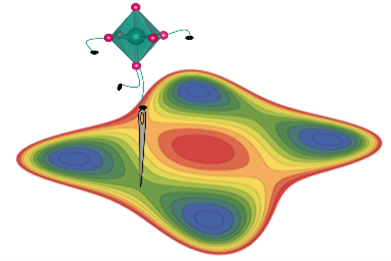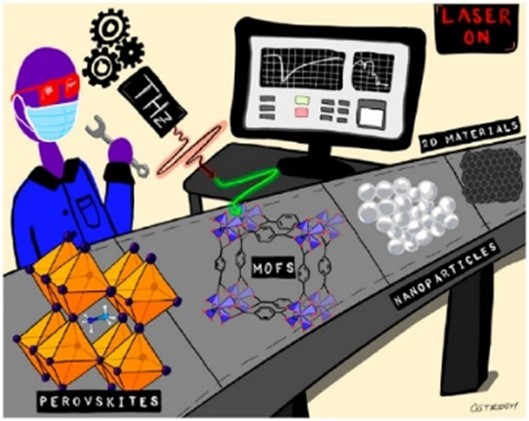Condensed Matter & Materials Physics focuses on the exploration and control of the materials that make up our world. It studies new complex behaviors that emerge when large number of atoms, ions, or molecules are put together. This field aims to harness the building blocks of matter to create materials with unique and useful properties, those that define the modern world (electrical conductivity, optical reflectivity, magnetism) and exotic properties/materials that are envisioned to shape the future (superconductivity, topological materials, Floquet engineered materials). The field leverages cutting-edge experiments, sophisticated theoretical models, powerful computational tools, and multidisciplinary teams to explore and manipulate matter across many scales - from the atomic and nanoscale to the micro and macroscale - solving real-world problems, shaping future technologies, and uncovering the influence the quantum world exerts on our daily lives.
Research in the field of CMP is conducted by Jingbiao Cui, Guru Khalsa, Arkadii Krokhin, Chris Littler, Marco Buongiorno Nardelli, Jens Neu, Jose Perez, Usha Philipose, Bibhudutta Rout, Yuanxi Wang, and Duncan Weathers.

The Optoelectronic Research Group, led by Dr. Jingbiao Cui, uses both microscopy and spectroscopy to understand the structure and fundamental properties of semiconductors and nanomaterials for potential applications in photonic, optoelectronic, and electronic devices. One of our focuses is to develop advanced materials with new functionality and to understand their property through interdisciplinary teamwork and collaboration. The novel materials under investigation include 2D layers, semiconductors, organic perovskites, and encapsulated organic nanostructures. We explore applications in solar cells, light-emitting diodes, photodetectors, and memory devices.

The Khalsa Research Group explores the connection between microscopic physics and the larger-scale response of condensed matter systems. Motivated by emerging experimental and industrial capabilities, the Khalsa Research Group uses a wide array of theoretical and computational tools to explore and enable emerging physics and expand the boundaries of existing technologies. This research is interdisciplinary and highly collaborative in nature, blurring the lines between physics; materials science; optics and photonics; ultrafast science; and conventional, unconventional, and quantum computing. The Khalsa Research Group is seeking enthusiastic students at all levels. Email Guru Khalsa (guru.khalsa@unt.edu) for more information.

Wang Research Group, led by Professor Yuanxi Wang, employs atomistic first-principles materials theory to understand solid-state physics in nanomaterials. Our current research focuses are quantum emitters based on defects, nonlinear optics, superconductivity, topological materials, and catalysis - all based on 2D or layered materials like graphene, 2D semiconductors, and air-stable 2D metals. Common theory tools include density functional theory, many-body perturbation theory, and empirical forcefields. Our work often involves tight collaborations with experimentalists across multiple disciplines, including the optical, mechanical, transport properties of 2D materials. See group website for details.

Marco Buongiorno Nardelli's research is at the forefront of computational materials physics and high-performance simulations, with particular emphasis on theoretical developments of ab initio DFT-based methods, high-throughput computational techniques and computational materials design. Recent activities also include the development of advanced electronic structure theories and algorithms for materials simulations on quantum computers, the application complexity science to various aspects of materials informatics, and the application of complexity theories and big data analysis tools to the structure of music as a generalized mathematical space. My work is intrinsically inter- and cross-disciplinary and provides a platform for Art/Science integration rooted in a profound and extensive expertise in development of scientific and artistic software and a strong vision for sustainable community software development. See ermes.unt.edu and www.materialssoundmusic.com for more information.

The Perez Lab is currently working on two-dimensional materials, particularly graphene and molybdenum disulfide. We recently started a project on hydrogen storage in graphene using electron irradiation of graphene at atmospheric pressure. This project has been funded by the National Science Foundation for three years, starting August 1, 2023. We aim to determine if the defects formed during electron irradiation are hydrogen adsorbates. We believe this is the case, and the mechanism is the electron-induced dissociation of adsorbed water into hydrogen that then adsorbs on the graphene. We will use tagged mass spectroscopy, scanning tunneling microscopy, Raman spectroscopy, and x-ray photoelectron spectroscopy to determine if the adsorbates are hydrogen. We are currently recruiting undergraduate and graduate students for this project. Further information can be found on our group site (https://sites.google.com/view/perezgroup).

The research focus of the nanoscale physics group led by Dr. Usha Philipose is centered around the synthesis and characterization of semiconductor nanomaterials, where the material properties are driven by dimensionality. The materials under study include two-dimensional (2D) thin films, one-dimensional (1D) nanowires, nanocomposites as well as ordered arrays of metal nanoparticles. The group has used these systems to study electrical transport and electron-phonon interactions, perform defect and noise spectrum analysis, and study temperature dependent conduction mechanisms. The potential of these nanostructures in applications including gas sensors, photodetectors, thermoelectrics and infrared detectors has also been demonstrated.

The semiconductor thin film research group led by Dr. Chris Littler and Dr. A.J. Syllaios fouses on the study of amorphous and crystalline thin films, relevant to infrared detector applications. The group's effort is directed at studying the key factors that influence the performance of such devices, with strategies employed to engineer/modify the intrinsic performance of these films. In addition to structural and optical characterization, the films are characterized in terms of their electrical properties including temperature coefficient of resistance and study of electrical noise. The goal is to improve these infrared material systems for next-generation IR sensors. With years of industry experience, this team is well-positioned to mentor students through their graduate school experience and be trained for industrial positions.

The Ultrafast THz Spectroscopy Group, led by Professor Jens Neu, uses THz spectroscopy to understand ultrafast photo physics in emerging materials; particularly what determines, and limits, the photo conductivity in novel materials. Understanding these limitations is the crucial step towards the development of next generation solar cell materials. We work as an interdisciplinary team and collaborate with outstanding engineering, material science and chemistry groups all over the world. We are seeking motivated graduate students and post docs, please see our homepage for more information.
 Photonics and acoustics group led by Prof. Arkadii Krokhin is carrying out theoretical and experimental research related to wave-matter interactions.
This wide area includes optics, plasmonics, and acoustics. We study optical and acoustic
properties of metamaterials, i.e., artificial structures exhibiting exotic physical
effects. Our research also extends to disordered structures where propagation of waves
is suppressed by the effect of Anderson localization. We accept students who like
to solve problems which require profound mathematical education and delicate physical
intuition. More details in our homepage UNT EFRI Group.
Photonics and acoustics group led by Prof. Arkadii Krokhin is carrying out theoretical and experimental research related to wave-matter interactions.
This wide area includes optics, plasmonics, and acoustics. We study optical and acoustic
properties of metamaterials, i.e., artificial structures exhibiting exotic physical
effects. Our research also extends to disordered structures where propagation of waves
is suppressed by the effect of Anderson localization. We accept students who like
to solve problems which require profound mathematical education and delicate physical
intuition. More details in our homepage UNT EFRI Group.